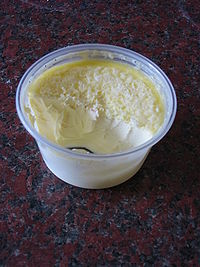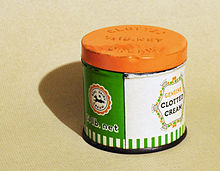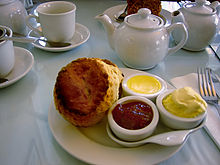- Clotted cream
-
Clotted cream
A tub of clotted cream, showing top crust.Origin Alternative name(s) Clouted cream, Devonshire cream Place of origin United Kingdom Region or state Cornwall, Devon Clotted cream (sometimes called clouted cream or Devonshire cream) is a thick cream made by indirectly heating full-cream cow's milk using steam or a water bath and then leaving it in shallow pans to cool slowly. During this time, the cream content rises to the surface and forms 'clots' or 'clouts'.[1] It forms an essential part of a cream tea.
Although its origin is uncertain, the cream's production is commonly associated with dairy farms in South West England and in particular the counties of Cornwall and Devon. The current largest commercial producer is Rodda's in Redruth, Cornwall, which produces up to 25 tonnes (25,000 kg; 55,000 lb) of clotted cream each day. In 1998 the term Cornish clotted cream became a Protected Designation of Origin (PDO) by European Union directive, as long as the milk is produced in Cornwall and the minimum fat content is 55%.
Contents
Description
"Its orient tinge, like spring-time morn,
Or baby-buttercups newly-born;
Its balmy perfume, delicate pulp,
One longs to swallow it all at a gulp,
Sure man had ne'er such gifts or theme
As your melt-in-mouthy Devonshire cream."An eulogy on a can of cream sent from a lady in Exeter. (extract)
—William Barry Peacock, Manchester, 1853[2]Clotted cream has been described as having a "nutty, cooked milk" flavour,[3] and a "rich sweet flavour" with a texture that is grainy, sometimes with oily globules on the crusted surface.[4][5] It is a thick cream, with a very high fat content (a minimum of 55%, but an average of 64%); in the United States it would be classified as butter.[6] Despite its popularity, virtually none is exported due to it having a very short shelf life.[6]
Clotted cream is often considered to be bad for health due its high saturated fat content.[7][8] For comparison, single cream has a lower fat content of 18%.[9] According to the United Kingdom's Food Standards Agency, a 100-gram (3.5 oz) tub of clotted cream provides 586 kilocalories (2,450 kJ), roughly equivalent to a 200-gram (7.1 oz) cheeseburger.[10]
History
Originally made by farmers to reduce the amount of waste from their milk, clotted cream has become so deep-rooted in the culture of South West England that it is now a tourist attraction.[11] While there is no doubt of its strong association with Cornwall and Devon, it is not clear where it first originated. It is similar to Kaymak (or Kajmak), a Near Eastern delicacy that is made throughout the Middle East, Southeast Europe, Iran, Afghanistan, India and Turkey. It is possible that it was introduced to Cornwall by Phoenician traders, who ventured to the area in search of tin.[12]
Whether or not it was brought to England from abroad, it has long been disputed whether clotted cream originated in Devon or Cornwall,[2] and which county makes it the best.[13] There is evidence that the monks of Tavistock Abbey were making clotted cream in the early 1300s.[14] After their Abbey had been ransacked by Vikings in 997 AD, the monks rebuilt it with the help of Ordulf, Earl of Devon. Local workers were drafted in to help with the repairs, and the monks rewarded them with bread, clotted cream and strawberry preserves.[15] The 1658 cookery book The Compleat Cook had a recipe for "clouted cream".[16]
In the 19th century it was regarded as better nourishment than "raw" cream because that cream was liable to go sour and be difficult to digest, causing illness.[17] An article from 1853 calculates that creating clotted cream will produce 25% more cream than regular methods.[18] In Devon, it was so common that in the mid-1800s, it was used in the formative processes of butter, instead of churning cream or milk. The butter made in this way had a longer lifespan and was free from any negative flavours added by the churning.[19]
It has long been the practice for local residents in South West England, or those on holiday to send small tins or tubs of clotted cream by post to friends and relations in other parts of the British Isles.[5] Food regulations for perishable goods prohibit it being sent abroad.[20]
EU directives
In 1993, an application was made for the name Cornish clotted cream to have a Protected Designation of Origin (PDO) in the European Union for cream produced by the traditional recipe in Cornwall. This was accepted in 1998.[21] Cornish clotted cream must be made from milk produced in Cornwall. It must also have a minimum butterfat content of 55%.[22] The unique, slightly yellow, Cornish clotted cream colour is due to the high carotene levels in the grass.[22]
Preparation
Traditionally, clotted cream was created by straining fresh cow's milk, letting it stand in a shallow pan in a cool place for several hours to allow the cream to rise to the surface, then heating it either over hot cinders or in a water bath, before a slow cooling.[4][23] The clots that had formed on the top were then skimmed off with a long-handled cream-skimmer, known in Devon as a a reamer or raimer.[23] By the mid-1930s, the traditional way of using milk brought straight from the dairy was becoming a rarity in Devon because using a cream separator, which actively separated the cream from the milk using centrifugal force, before heating produced far more clotted cream for the same amount of milk: as a farmer's wife in Poundsgate said, "the separator saves a whole cow!"[23]
Today, there are two distinct modern methods for making clotted cream. The "Float Cream method" includes scalding a floating layer of double cream in milk (skimmed or whole) in shallow trays. To scald, the trays are heated using steam or very hot water. After the mixture has been heated for up to an hour it is slowly cooled over 12 hours or more, before the cream is separated and packaged.[4] The "Scald Cream method" is similar, but the milk layer is removed and a layer of cream which has been mechanically separated to a minimum fat level is used. This cream is then heated in a similar manner, but at a lower temperature and after a set amount of time it is then chilled and packaged.[4] In the United Kingdom the resultant cream is deemed to be equivalent to pasteurised for legal purposes. Unlike pasteurisation, however, there is no requirement for the temperatures to be recorded on thermograph charts.[24] As the temperatures are lower than used in standard pasteurisation, much care is needed in ensuring high standards of hygiene.
Its principal high-volume Cornish manufacturer is Rodda's, a family-owned business based in Scorrier. Founded in 1890,[25] the company was producing over 1,000,000 pounds (450,000 kg) per year in 1985,[6] and in the run up to Christmas 2009 they were producing up to 25 tonnes (25,000 kg) of clotted cream per day.[25] In the early 1980s, Rodda's signed deals with international airlines to serve small tubs of clotted cream with the in-flight desserts,[6] and the company considers the annual Wimbledon tennis championships one of their peak selling periods. As a by-product, for every 100 imperial gallons (450 l; 120 US gal) of milk used, 94 imperial gallons (430 l; 113 US gal) of skimmed milk is produced, which is then used in food manufacture.[25]
One Devon manufacturer, Definitely Devon was purchased by Robert Wiseman Dairies in March 2006, closing one of the two Devon dairies and moving all production to Okehampton.[26] However, in 2011 Robert Wiseman sold the Definitely Devon Brand to Rodda's, who moved the production of Definitely Devon to Cornwall, which caused some controversy as the name was not changed,[27] prompting an investigation by Trading Standards.[28]
Throughout Cornwall and south-west England clotted cream manufacture is a cottage industry, with many farms and dairies producing cream for sale in local outlets. As clotted cream is not regularly available outside south-west England, there are a number of ways to create an approximation. One example is to mix mascarpone with whipped cream, a little sugar and vanilla extract.[29]
Outside Cornwall and Devon, clotted cream is produced in Somerset,[30] Dorset,[31] Herefordshire,[32] Pembrokeshire,[33] and the Isle of Wight.[34]
Usage
Cream tea
Main article: Cream teaClotted cream is an essential part of a cream tea, a favourite with tourists in Cornwall and Devon. It is served on scones — or the more traditional 'splits' in Cornwall[35] — with strawberry or raspberry jam, along with a pot of tea. Traditionally, there are differences in the way it is eaten in each county: in Devon, the cream is traditionally spread first on the scone, with the jam dolloped on top; in Cornwall the jam is spread first with a dollop of cream.[36] Cream teas spread to southern Australia as early immigrants from Cornwall and Devon took their traditional recipes with them.[37] In 2010, Langage Farm in Devon started a campaign for "Devon cream tea" to have protected designation of origin similar to "Cornish clotted cream".[38][39] One variation on a cream tea is called "Thunder and Lightning" which consists of a round of bread, topped with clotted cream and golden syrup, honey or treacle.[40]
Confectionery
It can be used as an accompaniment to hot or cold desserts. Clotted cream, especially clotted cream from Devon, where it is less yellow due to lower carotene levels in the grass, is regularly used in baking. It is used throughout the south-west of England in the production of ice cream,[41] and fudge.[42]
Savoury dishes
Clotted cream is used in some savoury dishes.[43] According to The Guardian "Like a rather special stock cube, a spoonful can work wonders in mashed potato, risotto, or with sauteed garlic mushrooms or scrambled eggs.".[44]
Historical
Cabbage cream (which does not contain cabbage) was a delicacy in the mid-17th century: layers of clotted cream were interspersed with sugar and rosewater, creating a cabbage effect when served.[45] In 1881 it was said to have all the health-giving properties of cod liver oil, with the benefit of a better taste.[2] It was a common accompaniment to junket, a milk-based dessert which went out of fashion in the mid-20th century.
Notable usages
During the reception following the wedding of Prince Charles and Lady Diana Spencer in 1981, one course was strawberries and Cornish clotted cream.[6] Clotted cream at the time was mainly eaten in the south-west of England and was uncommon in London, so was brought to Buckingham Palace directly by Rodda's.
Literature and folklore
It was mentioned in The Shepheardes Calendar, a poem by Edmund Spenser in 1579:
"Ne would she scorn the simple shepherd swain,
For she would call him often heam,
And give him curds and clouted cream."[2]As with many Cornish and Devonian icons, clotted cream has become entrenched in local folklore. For example, one myth tells of Jenny who enticed the giant Blunderbore (sometimes called Moran) by feeding him clotted cream. He eventually fell in love with her and made her his fourth wife.[46] Another myth, from Dartmoor, tells of a princess who wanted to marry an elven prince, but according to tradition had to bathe in pure cream first. Unfortunately, a witch who wanted the prince for her daughter kept souring the cream. Eventually, the prince offered the princess clotted cream, which the witch was unable to sour.[47]
See also
References
- ^ BBC Devon: article on clotted, or clouted, cream
- ^ a b c d Hawker, Rev. J. M. (1881), "Clouted Cream", Report and Transactions of the Devonshire Association 13: 317–323, http://www.archive.org/details/ReportTransactionsOfTheDevonshireAssociationVol131881
- ^ Figioni, Paula (2010). How Baking Works: Exploring the Fundamentals of Baking Science. John Wiley and Sons. p. 363. ISBN 0470392673. http://books.google.com/books?id=XqKF7PqV02cC&dq=clotted+cream+flavour.
- ^ a b c d Early, Ralph (1998). The technology of dairy products. Springer. pp. 45–49. ISBN 075140344X. http://books.google.com/books?id=BuR28Y-S4SMC&dq=clotted+cream.
- ^ a b Spencer, Nikki (30 May 1998). "The tartars of cream". The Independent. http://www.independent.co.uk/news/education/education-news/the-tartars-of-cream-1156842.html. Retrieved 2011-01-07.
- ^ a b c d e Anderson, Lisa (23 January 1985). "'Clotted cream' caviar of dairy". Ottawa Citizen. http://news.google.com/newspapers?id=ub4yAAAAIBAJ&sjid=W-8FAAAAIBAJ&pg=1298,1063710&dq=clotted+cream+legend&hl=en. Retrieved 3 December 2010.
- ^ "Scones with Clotted Cream and Jam". Icons of England. http://www.icons.org.uk/nom/nominations/scones. Retrieved 2011-03-01.
- ^ Clay, Xanthe. "Full fat takes the cream". The Telegraph. http://www.telegraph.co.uk/news/features/3633366/Full-fat-takes-the-cream.html. Retrieved 2011-03-01.
- ^ Barnett, Anne (1998). Understanding Ingredients. Heinemann. p. 26. ISBN 0435428276.
- ^ Food Standards Agency: Manual of Nutrition. HMSO London. 2008.
- ^ Terry Marsden; Jonathan Murdoch (2006). Between the local and the global: confronting complexity in the contemporary agri-food sector. Emerald Group Publishing. pp. 306–309. ISBN 076231317X. http://books.google.com/books?id=6285iMejcogC&dq=clotted+cream. Retrieved 2 December 2010.
- ^ Alan Davidson; Tom Jaine (2006). The Oxford companion to food. Oxford University Press. p. 225. ISBN 0192806815. http://books.google.com/books?id=JTr-ouCbL2AC&pg=PA225&dq=clotted+cream#v=onepage&q=clotted%20cream&f=false.
- ^ See for instance: A tour through Cornwall, in the autumn of 1808. Wilkie and Robinson. 1809. pp. 360–361. http://books.google.com/books?id=geYvAAAAYAAJ&dq=clouted+cream. and Spencer, Nikki (30 May 1998). "The tartars of cream". The Independent. http://www.independent.co.uk/news/education/education-news/the-tartars-of-cream-1156842.html. Retrieved 2011-01-07.
- ^ Lane, John (1998). In Praise of Devon: A Guide to Its People, Places and Character. Dundurn Press Ltd.. ISBN 1870098757.
- ^ "Did cream teas originate in Tavistock in 997AD". BBC News. 17 January 2004. http://www.bbc.co.uk/devon/news_features/2004/tavistock_cream_tea.shtml. Retrieved 3 December 2010.
- ^ The Comleat Cook: To make Clouted Cream, 1658
- ^ Sinclair, Sir John (1807). The code of health and longevity: or, A concise view, of the principles calculated for the preservation of health, and the attainment of long life. Printed for A. Constable & co. pp. 272–273. http://books.google.com/books?id=fj9KAAAAYAAJ&pg=PA272&dq=clouted+cream#v=onepage&q=clouted%20cream&f=false.
- ^ "Rural economy: The dairy". New York Times. 21 January 1853. http://query.nytimes.com/mem/archive-free/pdf?res=F50810FF385E167493C3AB178AD85F478584F9. Retrieved 3 December 2010.
- ^ The transactions of the Provincial medical and surgical association. Provincial Medical and Surgical Association, Worcester,. 1839. pp. 203–204.
- ^ "cornishcream.co.uk". Pengoon Farm. http://www.cornishcream.co.uk/. Retrieved 2011-01-07.
- ^ European Union directive: Directive 1998/98/EC of the European Parliament and of the Council of 30 September 1998 supplementing the Annex to Regulation (EC) No 2400/96 on the entry of certain names in the Register of protected designation of origin and protected geographical indications
- ^ a b "EU Protected Food Names Scheme — UK registered names — National application No: 03514: Cornish clotted cream". Department for Environment, Food and Rural Affairs. http://www.defra.gov.uk/foodfarm/food/industry/regional/foodname/products/registered/cornclcream.htm. Retrieved 2 December 2010.
- ^ a b c Fielden, Marjory Eckett (1934). "Old-time survivals in Devon". Report and Transactions of the Devonshire Association (Torquay: The Devonshire Press) LXVI: 367.
- ^ A. H. Varnam; Jane P. Sutherland (2001). Milk and milk products: technology, chemistry and microbiology. Springer. pp. 204–205. ISBN 0834219557. http://books.google.com/books?id=WorGTC1YjsIC&dq=clotted+cream+crust.
- ^ a b c "Interview with Nicholas Rodda". http://www.businesscornwall.co.uk/features/face-to-face-nicholas-rodda-123. Retrieved 2 December 2010.
- ^ "Forty-five jobs go in dairy close". BBC News. 23 October 2006. http://news.bbc.co.uk/1/hi/england/devon/6078182.stm. Retrieved 2 December 2010.
- ^ "Fury as 'Definitely Devon' clotted cream is made in Cornwall and label says add jam first". This Is Devon. 21 April 2011. http://www.thisisdevon.co.uk/Fury-Definitely-Devon-clotted-cream-Cornwall-label-saying-add-jam/story-11758309-detail/story.html. Retrieved 13 June 2011.
- ^ "Trading probe into 'Definitely Devon' claims". This Is Cornwall. 26 May 2011. http://www.thisiscornwall.co.uk/Trading-probe-Definitely-Devon-claims/story-12123391-detail/story.html. Retrieved 13 June 2011.
- ^ "Devonshire (Clotted) or Devon Cream Recipe". Joy of Baking. http://www.joyofbaking.com/DevonshireCream.html. Retrieved 3 December 2010.
- ^ St James's Restaurant at Fortnum & Mason
- ^ Afternoon tea at the Heights - serving a traditional Dorset cream tea
- ^ The Teashop, Ross-on-Wye
- ^ Welsh Icons: Welsh Dairy Products
- ^ Calbourne Classics Isle of Wight clotted cream
- ^ Nigel Slater's Devonshire cream tea recipes, The Guardian, 22 August 2010
- ^ "How do you do take your cream tea?". BBC News Online. 9 June 2010. http://news.bbc.co.uk/local/cornwall/hi/people_and_places/newsid_8694000/8694384.stm. Retrieved 2 December 2010.
- ^ Wilfrid Prest, Kerrie Round, Carol S. Fort (2001). Wakefield Companion to South Australian History. Wakefield Press. p. 210. ISBN 1862545588. http://books.google.com/books?id=EDgPo8KWKh4C.
- ^ "Cream teas battle rages between Devon and Cornwall". The Daily Telegraph. 20 May 2010. http://www.telegraph.co.uk/foodanddrink/7746090/Cream-teas-battle-rages-between-Devon-and-Cornwall.html. Retrieved 3 December 2010.
- ^ "Devon cream tea campaign put to government". BBC News Online. 8 June 2010. http://www.bbc.co.uk/news/10262655. Retrieved 2 December 2010.
- ^ "Britain's Best at Teatime". The New York Times. 5 September 1982. http://www.nytimes.com/1982/09/05/travel/britain-s-best-at-teatime.html. Retrieved 2007-01-28.
- ^ For example: "Kelly's of Cornwall products". http://www.kellysofcornwall.co.uk/products. Retrieved 2010-12-03.
- ^ For example: "Radford's Fine Fudge". http://www.radfordsfinefudge.co.uk/about.html. Retrieved 2011-03-22.
- ^ BBC food: clotted cream, page with some savoury recipes
- ^ Guardian newspaper - Clotted cream: the perfect summer treat
- ^ A gift to young housewives. Indiana University Press. 1998. pp. 368–369. ISBN 0253212103.
- ^ Viccars, Sue (2011). Frommer's Devon and Cornwall With Your Family. Frommer. p. 238. ISBN 0470749474.
- ^ Sandles, Tim. "Dartmoor Clotted Cream". Legendary Dartmoor. http://www.legendarydartmoor.co.uk/clott_cream.htm. Retrieved 2010-12-03.
Culture of Cornwall Symbols 
Festivals Sports Cuisine Cloam oven · Clotted cream · Cornish cream tea · Cornish fairings · Cornish Gilliflower · Hevva cake · Hog's pudding · Pasty · Saffron bun · Stargazy pie · Yarg
Arts Music Cornish bagpipes · Brenda Wootton · Gwenno Saunders · Fisherman's Friends
Folk songsLanguage Folklore Beast of Bodmin · Blunderbore · Bucca · Cruel Coppinger · Knocker · King Arthur · Lyonesse · Owlman · Piskie
Organisations Cornwall portal Categories:- Dairy products
- British products with protected designation of origin
- Spreads
- Cornish cuisine
- Devonshire cuisine
Wikimedia Foundation. 2010.




